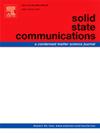The effects of hydrogen on the bonding properties of SiC/Cu interface via first-principles calculations
IF 2.1
4区 物理与天体物理
Q3 PHYSICS, CONDENSED MATTER
引用次数: 0
Abstract
Ceramic/metal interfaces own great importance of technology, but the weak interface bond limits their applications. In this work, the effects of doping H element on the stability and bonding properties of SiC/Cu interface are studied by first principles calculations. In order to study the stability of interface, the potential surfaces were firstly studied for the C and Si terminated SiC/Cu interfaces. The C terminated interface is more stable than the Si terminated interface, which contributes the largest work of adhesion of 3.998 J/m2. The effects of hydrogen on the interface bonding properties were further studied. The occupation properties of hydrogen atoms were then studied, the hydrogen tends to occupy the octahedral position with negative formation energy. To reveal the bonding strength of SiC/Cu interface, the tensile simulations were carried out. The hydrogen owns obvious effects on the tensile strength depends on its occupation site. The movement and diffusion properties of hydrogen atoms in the interface zone were studied combining molecular dynamics and climbing image nudged elastic band method. Finally, the bonding mechanisms were analyzed by combining charge density, state density, differential charge and bader charge. Based on the above calculation results, it is found that for SiC(001)/Cu(111) interface, the H element generally has a negative impact on the bonding properties of SiC/Cu interface.
通过第一原理计算研究氢对 SiC/Cu 界面键合特性的影响
陶瓷/金属界面在技术上具有重要意义,但界面结合力弱限制了其应用。本研究通过第一性原理计算研究了掺杂 H 元素对 SiC/Cu 界面稳定性和结合性能的影响。为了研究界面的稳定性,首先研究了 C 和 Si 端接的 SiC/Cu 界面的势面。C 端界面比 Si 端界面更稳定,其粘附功最大,为 3.998 J/m2。我们进一步研究了氢对界面键合特性的影响。然后研究了氢原子的占据特性,氢倾向于占据负形成能的八面体位置。为了揭示 SiC/Cu 界面的结合强度,进行了拉伸模拟。氢对拉伸强度的影响取决于其占据的位置。结合分子动力学和攀登图像点弹带法,研究了氢原子在界面区的运动和扩散特性。最后,结合电荷密度、态密度、差电荷和巴德电荷分析了成键机理。根据上述计算结果发现,对于 SiC(001)/Cu(111)界面,H 元素一般会对 SiC/Cu 界面的键合特性产生负面影响。
本文章由计算机程序翻译,如有差异,请以英文原文为准。
求助全文
约1分钟内获得全文
求助全文
来源期刊

Solid State Communications
物理-物理:凝聚态物理
CiteScore
3.40
自引率
4.80%
发文量
287
审稿时长
51 days
期刊介绍:
Solid State Communications is an international medium for the publication of short communications and original research articles on significant developments in condensed matter science, giving scientists immediate access to important, recently completed work. The journal publishes original experimental and theoretical research on the physical and chemical properties of solids and other condensed systems and also on their preparation. The submission of manuscripts reporting research on the basic physics of materials science and devices, as well as of state-of-the-art microstructures and nanostructures, is encouraged.
A coherent quantitative treatment emphasizing new physics is expected rather than a simple accumulation of experimental data. Consistent with these aims, the short communications should be kept concise and short, usually not longer than six printed pages. The number of figures and tables should also be kept to a minimum. Solid State Communications now also welcomes original research articles without length restrictions.
The Fast-Track section of Solid State Communications is the venue for very rapid publication of short communications on significant developments in condensed matter science. The goal is to offer the broad condensed matter community quick and immediate access to publish recently completed papers in research areas that are rapidly evolving and in which there are developments with great potential impact.
 求助内容:
求助内容: 应助结果提醒方式:
应助结果提醒方式:


